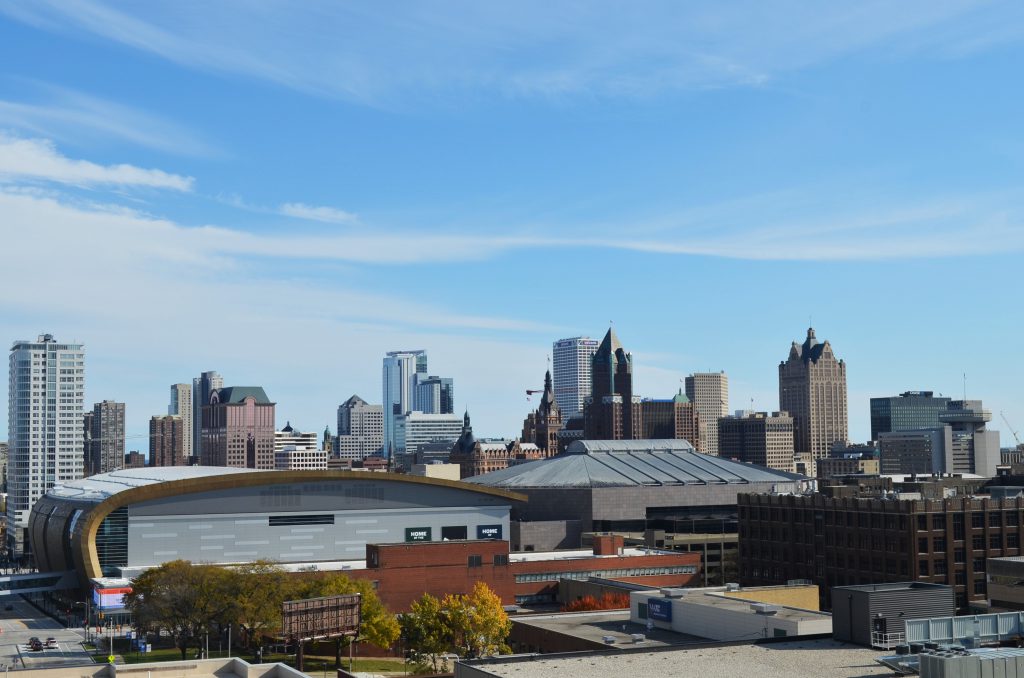The Tale of Two Milwaukees
Oft-used phrase helps explain the disinvestment in Black neighborhoods.
With the COVID-19 pandemic and uprisings in response to the police killings of Black people, Milwaukee finds itself at a crossroads, where it has been many times before. In the City of Milwaukee, 57 percent of the deaths from COVID-19 have been Black Milwaukeeans who comprise 39 percent of the city’s population. The June 12 police killing of Rayshard Brooks, who was sleeping in his car in an Atlanta drive-thru, evokes Officer Christopher Manney’s killing of Dontre Hamilton in 2014, who was sleeping on a bench in front of Starbucks in Red Arrow Park. Hamilton’s death underscored a deadly connection between Milwaukee’s Downtown redevelopment strategy and the policing of Black Milwaukeeans. The police killing of Sylville Smith in 2016, and the subsequent Sherman Park uprisings, revealed the toxic connection between police violence and incessant disinvestment from Black neighborhoods.
After each of these and countless other incidents, elected officials had opportunities to stop “business as usual.” And every time, elected officials, bureaucrats, and business elites used the pernicious “tale of two Milwaukees” to make it appear as if they were exposing and dealing with segregation and economic inequality when in fact, the narrative itself has become an alibi to continually overdevelop Downtown and underdevelop Black neighborhoods. If Milwaukee takes this opportunity to work for the liberation of the entire city, we have to expose the insidiousness of “the two Milwaukees” narrative and leave it behind.
I heard the tale repeatedly. It was, and still is, told as if it were a fact of nature. In the words of one elected official, “[Milwaukee is] the area with the most concentrated wealth in the state of Wisconsin, but it’s also the area of the most concentrated poverty in the state.” In my research, I found that the tale has immense purchase for policymakers, the business elite, and boosters in how racial inequality and segregation is understood and acted upon or not.
The power of the tale comes from its ability to pose fake solutions to the very problems it creates. Not only does the tale makes a divide between Black and white Milwaukee seem natural and inevitable, the tale makes it seem as though white and wealthier Milwaukee is not implicated in maintaining this mythical divide. These rhetorical and spatial divides between Black and white Milwaukee function as common sense, so that the disinvestment in public schools, public transportation, and jobs for Black Milwaukee and the investment in amenities for affluent, majority white Milwaukee become a self-fulfilling prophecy.
If Milwaukee is to progress towards racial justice, it must acknowledge that these two Milwaukees are deeply intertwined and necessarily reinforce the other’s existence. Without recognition that the wealth of the East Side and the suburbs comes from the impoverishment of the North Side, efforts to improve the city will never work. So instead of public subsidies for cool lifestyles and amenities to gain attention for being what Vogue magazine called “the Midwest’s coolest (and most underrated) city,” decision makers need to act upon Black activist demands of livable neighborhoods and life-sustaining jobs.
Once again, the Common Council has an opportunity to act on the demands of Black and brown community leaders, including youth. The Council has proposed a 10 percent cut to the police budget but, the LiberateMKE campaign of the African American Civic Engagement Roundtable specifically demands a much larger $75 million divestment from the Milwaukee Police Department (MPD) to be reinvested in Black and brown communities. Leaders Igniting for Transformation (LIT), radical youth of color organizers, spearheaded a successful campaign to remove MPD officers from Milwaukee Public Schools and to reinvest those funds towards counselors and restorative justice for educators. These campaigns and the daily marches taking place in all neighborhoods (including those that call themselves “suburbs”) underscore how Milwaukee is one city. The name LiberateMKE itself actively defies the “tale of two Milwaukees” by highlighting how the whole city is oppressed and needs to be liberated.
Yui Hashimoto is a postdoctoral fellow at the Dartmouth College Society of Fellows and Department of Geography. She received her PhD in Geography and Graduate Certificate in Women’s and Gender Studies from the University of Wisconsin-Milwaukee in 2018.
More about the 2020 Racial Justice Protests
- Plea Agreement Reached On Long-Pending Sherman Park Unrest Charges Involving Vaun Mayes - Jeramey Jannene - Oct 17th, 2024
- Rep. Ryan Clancy Settles With City Following 2020 Curfew Arrest - Jeramey Jannene - Dec 12th, 2023
- Supervisor Clancy Applauds Settlement in Clancy vs. City of Milwaukee - State Rep. Ryan Clancy - Dec 12th, 2023
- Tosa Protest Assails Federal Court Decision Exonerating Police - Isiah Holmes - May 9th, 2023
- Wauwatosa ‘Target List’ Trial Begins - Isiah Holmes - May 3rd, 2023
- Shorewood Spitter Found Guilty For 2020 Protest Confrontation - Jeramey Jannene - Apr 20th, 2023
- City Hall: City Will Pay 2020 George Floyd Protester $270,000 - Jeramey Jannene - Feb 14th, 2023
- Tosa Protest Tickets Dismissed - Isiah Holmes - Jul 21st, 2022
- Op Ed: ‘We Need More’ - Charles Q. Sullivan - Mar 4th, 2022
- Milwaukee Officers Circulate “2020 Riot” Coins? - Isiah Holmes - Nov 14th, 2021
Read more about 2020 Racial Justice Protests here
Op-Ed
-
Unlocking Milwaukee’s Potential Through Smart Zoning Reform
 Jul 5th, 2024 by Ariam Kesete
Jul 5th, 2024 by Ariam Kesete
-
We Energies’ Natural Gas Plans Are A Mistake
 Jun 28th, 2024 by John Imes
Jun 28th, 2024 by John Imes
-
Milwaukee Needs New Kind of School Board
 Jun 26th, 2024 by Jordan Morales
Jun 26th, 2024 by Jordan Morales




















